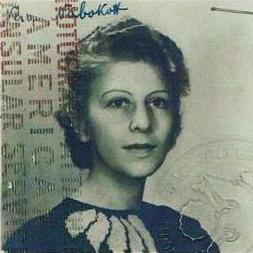Véra Nabokov’s immigration file
Last week, I wrote up Vladimir Nabokov’s immigration file as the first in a series of archival materials that will appear on the Records page of this website. Today, I wanted to highlight a few details from the file of his wife, Véra Nabokov.
Véra had the same strange discrepancy in recorded height that appeared on Nabokov’s forms, going from 5’6” in France to 5’10” on her American papers. Like her husband, she listed his younger brother Sergei as her nearest relative, despite the fact that Sergei had expressed regret over Véra’s marriage to Vladimir.
 Véra’s own younger sister, Sonia Slonim, was also still in Paris at the time. But she was caught up in espionage drama with which Véra might not have wanted to be associated in that moment. (I’ll post Sonia’s immigration file soon, but for details on Sonia’s political intrigues, you should read The Secret History.)
Véra’s own younger sister, Sonia Slonim, was also still in Paris at the time. But she was caught up in espionage drama with which Véra might not have wanted to be associated in that moment. (I’ll post Sonia’s immigration file soon, but for details on Sonia’s political intrigues, you should read The Secret History.)
Véra’s hair went from “blond” on visa forms in 1940 to “grey” five years later on her naturalization papers—which is hardly surprising, given that she also turned forty in that window. As was required by the race-obsessed immigration policies of the day, she is categorized as “Hebrew.”
She is “Russian” on one form, though on the official visa, it is made clear (as it was on her husband’s) that she is “without nationality,” having fled Russia before the formation of the Soviet Union. Like Nabokov, she had to present a stamped certificate from the Office of Russian Refugees attesting that she was a refugee but had been born in Russia to Russian parents, as well as providing a copy of her criminal record issued by the Ministry of Justice, showing she had never been arrested.
On a side note, Leslie Weisenburg, the vice-Consul at the American Embassy in Paris who signed Véra’s visa—allowing her to avoid the unpleasant odds facing a foreign Jew trapped in what would soon become Occupied France—was himself arrested later in the southern French “free zone.” Weisenburg was interned in a German concentration camp with his family before being released with them early in 1943. In September of the following year, he was sent back to Paris with Charles de Gaulle as part of a team dealing with diplomatic relations during the liberation of France.
You can see Véra Nabokov’s immigration file in its entirety here.
(Information on Weisenburg taken from “Weisenburg Goes to Post in Paris” in The Free-Lance Star, September 28, 1944, p. 5 and “Leslie Weisenburg, Consul in Paris, Succumbs at 63,” in the same publication, dated August 31, 1956, p. 2).

There are 1 Comments to "Véra Nabokov’s immigration file"
Thank you for posting this…Les Weisenburg was my great-uncle. I know little about him, or his time in the US Consular office, but from what I understand his policy at that time was to grant an American visa to any Jewish refugee that came in, no questions asked.